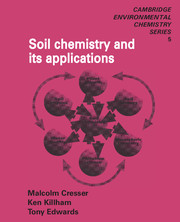7 - Soils and pollution
Published online by Cambridge University Press: 05 August 2012
Summary
From the dawning of pre-history, the human race has used soil as a depository for the waste products of its activities. Excrement, human and animal remains, ashes, crop and food residues and the superfluous scrap of its low-tech industries would be dumped in pits or simply left to lie on the surface. There the detritus would be subject to microbial and chemical decomposition, depending upon what it was. At this stage the boundary between pollution and natural biogeochemical recycling was not particularly distinct. Man was just one of many animal species producing waste materials. One major difference between humans and other animals, however, lies in the scale in which they tend to congregate into communities, thus generating zones with very substantial quantities of waste for disposal. A second divergence comes from the ability to use tools, which massively escalates the capacity for refuse production. One of these tools, fire, may lead to contamination of the atmosphere, as well as to solid residues for disposal. Thus it is the scale of human activities, rather than their fundamental nature, which leads to what are generally conceived as pollution problems.
Most people regard pollution as the result of subjecting ecosystems to loads of waste which are so great that they interfere perceptibly with the quality of the environment. Obnoxious smells in the air, tainted water supplies, visibly damaged trees and crops, animals or humans suffering from toxicological problems, or visible waste accumulation fall into this category.
- Type
- Chapter
- Information
- Soil Chemistry and its Applications , pp. 151 - 167Publisher: Cambridge University PressPrint publication year: 1993



